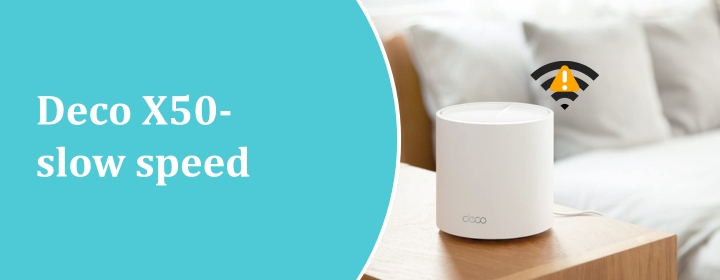
Deco X50-slow speed
You have expected to have fast WiFi with the Deco X50, but you are left wanting to watch that speedometer persistently fluctuate between 20-100 Mbps. What’s going on? If this is happening continuously & you cannot find any practical reason for it, then this article is the solution that you need
Read this thoroughly to how to deal with Deco X50 sluggish speed, and incorporates how Deco X50 Setup, tp-link deco login, tp link deco setup all contribute to performance.
The symptoms
- Might I give you a description of what people see:
- Hard wired Ethernet connection to the Deco to your modem only supports about 100 Mbps rather than gigabit.
- Slow wireless connections with speeds much lower than what your service provider boasts of even when just near the gadget.
- You are warned about Abnormal WAN speed that you can observe in the Deco app.
- The upload speeds are low as compared to the download speeds.
- There are huge variations in performance, one hour good, and the second hour unusable.
Test Deco X50 Network topology
You are not ready to invest much in the highest level of tweaks before you can be sure that your Deco X50 Setup is working right. Most of the troubles are often due to simple misconfigurations.
Tp-link deco login fundamentals and restrictions
Additional diagnosis requires more frequently access to the management interface:
- Manage your mesh network with the Deco app lots of advanced features are only available in an app form.
- In a browser, web login can be attempted with either of the following addresses: or IP of the LAN (typically, 192.168.68.1).
- The web interface is clustered; Deco is expected to be operated through app. Other users go to an extent of complaining that the web interface is virtually useless.
- When you are not able to access the login-page, disable browser cache, use a different browser or use the app to ensure the IP of the Deco has not changed.
Most common reasons for slow internet
- The following list will summarize some of the factors that usually slow down speeds:
- QoS, Limits in Bandwidth or Prioritization of devices.
- QoS may limit speeds in case tight rules are enabled or devices have poor priority. Some of the users turn QoS off all around and recover the performance.
- UPnP, SIP ALG, NAT forwarding, functionality.
- These are services that are of assistance and other times they corrupt traffic. Disabling SIP ALG or UPnP is helpful in most cases of slow speeds.
Firmware bugs
Obsolete firmware may contain performance regressions or bugs that reduce performance. Always upgrade through Deco X50 Setup or through the app.
Ethernet link degradation
Defective cables or broken ports might fall down to 100 Mbps. Certain users had realized that though the ISP connection was gigabit, their Deco was performing in 100 Mbps due to cable or port errors.
Mesh backhaul constraints
The backhaul channel is saturated when nodes communicate to one another via WiFi (and not via the wired backhaul). Raise the wall, raise the interference, the distance–kills speeds.
Mode Conflicts
When Deco is operating in the unsuitable mode (e.g. double NAT, or is configured to act as an Access Point in reverse), the routing overhead may suck up speed. The switching to AP mode or the mode adjustments improved throughput in some clients.
Step-by-step fixes
- The following unsightly yet useful collection of questions would do:
- Restart all: turn off all Deco units and modem and after 10 seconds, open the modem – main Deco – satellites. Weird routing problems can be cured by simply rebooting.
- Connect straight to one laptop on the Deco using Ethernet cable, performance test. In case the speed remains poor, the speed issue is either upstream or in WAN connection of Deco.
- In tp link deco setup (through app/login), you need to turn off QoS, turn off SIP ALG/UPnP temporarily, and eliminate bandwidth limit.
Upgrade firmware of Deco units
- Check whether WAN port is not greater than (not down-negotiated) 100 Mbps. In case it is 100 Mbps change the cable or port.
- When performing wireless backhaul on the decos, because of the signal loss, you can use wired backhaul instead or just move the nodes further to minimize the signal loss.
- In case there are conflicting modes, attempt to cycle Deco between Access Point mode (or Router mode) and give it a test.
- Should everything go bad, the only way out is to have a factory reset of every Deco (hold reset button about 10 seconds until light blinking) and begin again with Deco X50 Setup.
Final thoughts
Also, do not wonder why Deco X50 (or any consumer mesh) does not produce 100 percent of ISP gigabit to every part of your house/office. The highest speeds are in theory only in short distances, low interference situations.
The tp link deco login / app can be used to check the usage, logs, and errors. It helps knowing that it is a node or device whose things are being dragged. When there is sustained low speed in spite of all the adjustments, it may be time to think of better mesh systems, or add wired access points to important devices.
